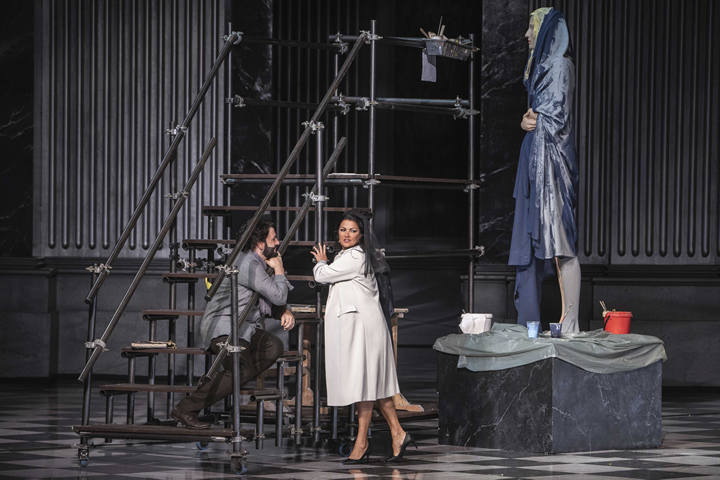| Opera Reviews | 5 May 2024 |
Netrebko plays Netrebkoby Moore Parker | |
Puccini: Tosca |
|

|
|
|
Revived from its original Salzburg showing at the 2018 Easter Festival, Michael Sturminger’s Tosca was re-cast on this occasion with a new line-up on the stage (as well as the pit) which looks impressive on paper - with today’s most lauded soprano and spouse undertaking the romantic leads, and with the top French baritone of our time playing the villain. Sturminger’s concept also brings a number of unconventional ideas to the piece. Puccini’s thundering opening brings a shootout between Angelotti and the local Roma Carabinieri in an underground car park (sets by Renate Martin and Andreas Donhauser). Slickly-negotiated ramps transform the generous spread of the Grosses Festspielhaus into Rome’s Sant’Andrea della Valle with a grand statue (rather than the typical oil painting) clad with scaffolding and awaiting the artist’s brush. The Sacristan makes his first appearance guiding a group of young children - there for a school outing with their notebooks and pencils. Set in the second half of the 20C, Tosca swirls an ivory-coloured knee-length coat while sporting divaesque sunglasses and a crystal-studded handbag (which itself received pre-premiere press and which appears to enjoy a role of its own) in Act 1. Novel ideas in Act 2 include Scarpia in an armless vest treading his home trainer as the curtain rises - attended by fussing maids and a housekeeper who relieve him of any effort in donning his suit and tie. The centrepiece is an enormous teak desk (which serves for an attempted rape scene, as well as Tosca’s first bars in 'Vissi d’arte'), leaving the obligatory supper table to be carried in as an aside. When Tosca’s knife finally strikes, Scarpia takes the blade below his left ribcage. Neither candles nor crucifix round off the scene as Tosca proudly strides out; just sufficient music in the score for Scarpia to rise and reach for the telephone on his desk as the curtain drops. Act 3 sees a boys’ dormitory with its occupants beginning their day with small firearms training. The terrace of Castel Sant’Angelo is replaced by a rooftop signposted Il Divo, with St. Peter’s visible in the horizon. Scarpia’s henchmen huddle in a corner consuming beer and other substances while waiting out 'E lucevan e stelle.' 4am strikes, and Cavaradossi takes position. His execution squad is made up of several of the young boys. The group remains in full view while Tosca goes through her 'O Mario non ti muovere,' and with Puccini’s final pages (in which Tosca generally flees her pursuers) Scarpia ascends the spiral staircase, bloodstained and armed for revenge. He shoots Tosca as she hurls out 'O Scarpia, avanti a Dio!' The production was roundly booed at the curtain! Reception-wise, the performers fared better - but, with showings which hardly extended beyond routine - fell far short of typical premiere festival nights boasting star casts. When asked, Callas warned Montserrat Caballé to steer well away from Lady Macbeth and Abigaille in Nabucco. She took her advice. Anna Netrebko has not shied away from tackling these and some of opera’s other most demanding parts - most recently, Turandot at Verona’s arena (again alongside her spouse, Yusif Eyvazov). The passing of time coupled with these challenges have not left her instrument unscathed - with delivery on this occasion unruly and at times, a touch precarious. 'Vissi d’arte' was, however, well-gauged and sold as a show-stopper from the footlights. Despite the diva’s customary ebullience, the show was somehow coloured with a sense of Netrebko playing Netrebko. Eyvazov’s efforts as Cavaradossi were variable - his intrinsically brittle timbre only occasionally providing desired romantic lyricism, and possibly prompting his choice to include a series of protracted top notes in compensation. However, he delivered decent renderings in both his first and final act arias - the latter, again, performed upstage centre. Ludovic Tézier’s fine baritone amply possesses the weight and sustaining power for Scarpia, but the part remains as yet elusive to this eloquent singer - currently lacking the true elemental authority from which to spin any chosen interpretation, and ultimately failing to ignite. Of the supporting roles, Michael Mofidian delivered a solid Angelotti while Alexander Köpeczi’s brief moment as the Jailer showed promising timbre. Conductor, Marco Armilliato’s reading suffered a lack of impetus and structure on this occasion - rather appearing to follow the will of the stage too often and failing to drive the action forward, despite the Vienna Philharmonic’s customary standards in all sections of the band. In all, this Tosca proved something of a damp squib as the last official premiere of this Salzburg Festival opera season.
|
|
Photo © SF / Marco Borrelli |
|







